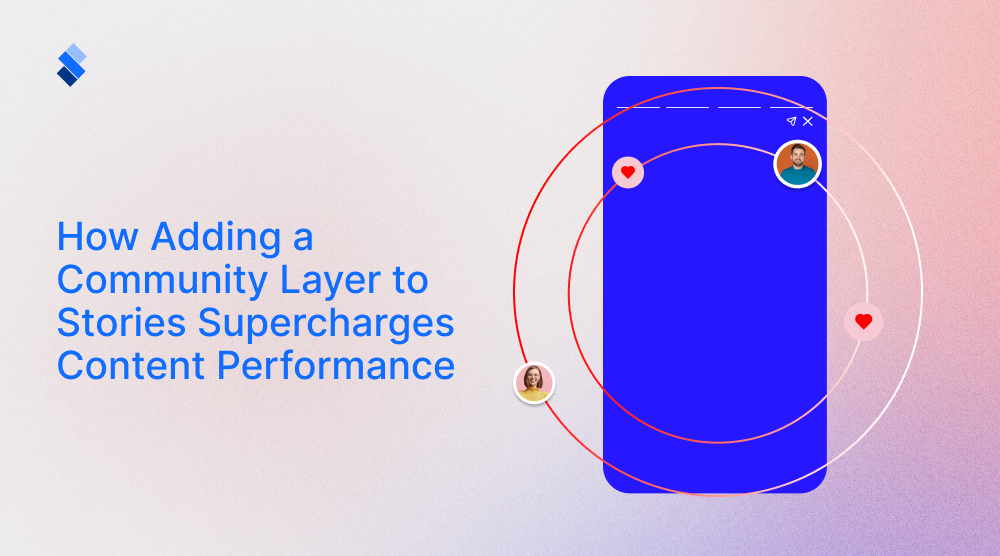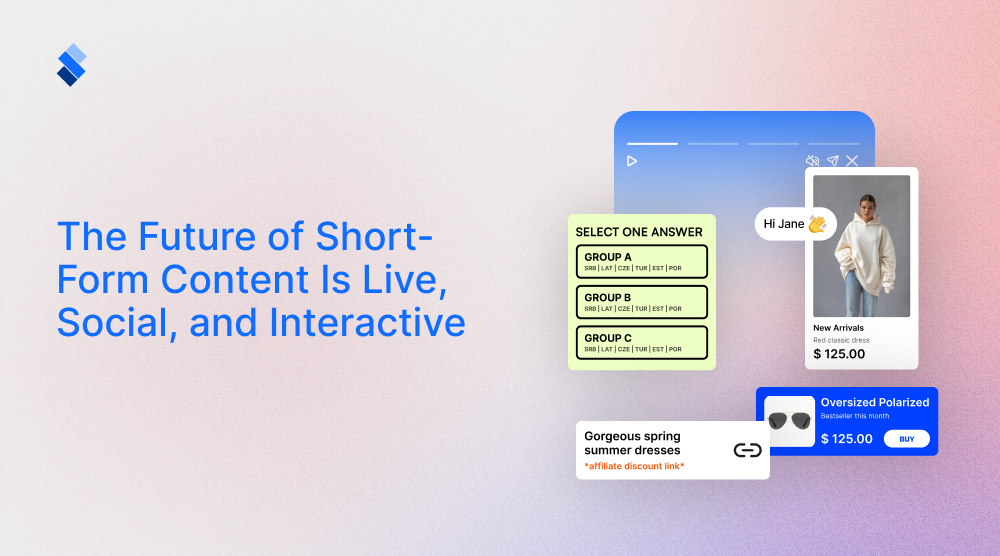Using web stories as integral part of a user engagement strategy
Long-term marketing always includes a well-made user engagement strategy. And you'd be surprised how effective web stories can be in one.

Having an engaged audience is a dream for any brand manager. After all, what is better than to have your customers interact with your content and regularly monitor what you'll post next. But, unfortunately, finding ways to engage customers is rarely easy. First, you need to understand what your customers like to engage with. And you need to know how to make your content worth the engagement. Luckily, in both of these instances, web stories can be surprisingly useful. So, let's explore how web stories can and should be a part of a broader user engagement strategy.
Developing a user engagement strategy
It doesn't take much marketing experience to learn that user engagement isn't something you tackle in one go. To find, develop and upgrade customer engagement you need to understand both them and your brand. The more ways you can find to connect the two, the more options you'll have to develop a long-lasting relationship with your customers.
Outlining the target demographic
The first step in establishing a user engagement strategy is to outline your target demographic. No brand, not even Coca-Cola, can hope to engage everyone. No matter how universal you feel your brand is, it will always strike a chord only within a specific demographic. So, the sooner you outline what that demographic is, the sooner you can look to engage it.

For this, we suggest that you do ample prior research. This includes researching what your competitors are doing, and whether you can build upon their mistakes and oversights. It also includes consulting with more experienced marketing managers. Especially those that worked within your industry. The more research you do, the fewer mistakes you are going to make. So, don't shy away from doing your homework.
Introducing personalization
The next step is to improve your engagement through personalization. Unfortunately, it is no longer profitable to simply outline the target demographic and address them as a homogenous entity. All target demographic is comprised of different segments. And while those groups do have certain things in common, you'd be smart to also take their differences into account. This is precisely where personalization comes in. Through it, you can look to engage the customers with the right content, at the right time. By doing so, you drastically increase the odds that they will engage with you and that your engagement will be fruitful.

Experiment with content
One of the main reasons for outlining your target audience as soon as possible is the ability to create and promote the right content. Far too often, brands spend time and money on content that is unsuited for their audience. Either the type of content, the format, or the brand placement simply doesn't hit the mark with the audience. Once you outline what your audience actually responds to, you can look to invest in improving both the content quality and the amount of it you put out. But, some experimentation is necessary along with ample research. Especially if you wish to make your marketing cost-effective.
Offer benefits to loyal customers
In the modern age of high availability and seemingly endless marketing content, you can hardly hope that your customers will remain faithful to your brand. Offering decent products and/or services simply isn't enough to keep your customers engaged with your brand. Instead, you need to provide clear incentives for their loyalty. These can be:
- Premium membership programs.
- Seasonal loyalty rewards.
- Exclusive products/services for loyal customers.
Whatever works best within your company should become a part of your everyday dealings.
Brand development
You need to do your best to develop your brand with user engagement in mind. If done properly, your brand will convey a marketing idea that your customers find interesting and alluring. Know that a good brand goes a long way in making your company memorable. And, as such, it stands to come up once the customers feel the need for your services. Every aspect of customer engagement will entail brand placement, which is why it is paramount that you have a good brand to place in the first place.

If you haven't done so far, we would suggest that you consult with a professional designer before you develop your brand. Logos in particular can be difficult to create. They seem easy enough. But this is true for any minimalist design. For it to convey the core idea of your company, it needs professional work or at least professional input. Keep in mind that large companies spend a lot of time picking the right colors and ensuring that their brand looks as good as possible before they put it into marketing.
Mobile-friendly design
Finally, it is worth noting that a large part of your audience will use mobile devices to view your content. Regardless of what your target demographic is like, you'd be a fool not to optimize your content with mobile devices in mind. By doing so you ensure that your content is easily sharable and that people can access it wherever they need be.
Where do web stories fit in
Now that we've covered the basics of a long-term user engagement strategy, let's see where web stories fit in. As they stand now, web stories hold a unique marketing potential. They are both fairly easy to create, and fairly easy to personalize for various demographics. Furthermore, when it comes to capturing the viewer's attention, you'd be hardpressed to find a type of content that works better than web stores. So, with all this potential in mind, how can you use web stories within a user engagement strategy?
Gathering customer data
Web stories, by design, invite interactivity for the viewer. If you look at them as short, well-crafted, digestible content that the viewer is bound to notice, it is easy to see why brands often chose to use them for gathering data. Namely, it is quite easy to place pools or questionnaires within a web story. If you wish your viewers to fill out more in-depth contact info, you can use web stories to explain why you need such data. A simple link to a page dedicated to gathering declared data is easy enough to place in a web story. And you'd be surprised how willing people are to provide the necessary data, especially if you give them a bit of incentive for doing so (remember the benefits for loyal customers).

When it comes to inferred data, web stories can also be of use. Namely, different demographics tend to respond to different kinds of web stories. For instance, younger people tend to respond to flashy, energetic, and overall fun stories. While elderly people prefer slower, calmer, and more wholesome content. With this in mind, you can use web stories to experiment and see what your viewers respond to. The better the response to one type of web story, the more reliably you will know what your audience is like.
Easy personalized content
The simplest format for an effective web story is a combination of an image and words. You use the image to invoke a specific emotion within the viewer. And you use the words to convey the necessary information. Put the two together and you have a dance piece of content that the viewer will notice, and read in its entirety. As such, web stories are fairly easy to personalize, even without professional help.
Namely, once you learn who constitutes your target demographic, and segment it properly, you can look to create specific web stories for each segment. You can outline different images for each segment, and provide personalized info for each person. This is only a bit more complicated than written content, as it involves the visual aspect. But, it is far more likely to draw the attention of your viewers, and properly convey the message. As such, web stories are not only effective in engaging your audience, but also quite easy to create with high personalization in mind.
Cost-effective experimentation
This cost-effectiveness makes web stories ideal for experimentation needed for improved user engagement. Namely, it is quite easy to see which web stories resonate better within your target demographic. You can experiment with whether the emotional setting brought by the image is unsuited. Or if the written content isn't clear or engaging enough. You can change the tone, the font, and the writing style of your web stories in order to find the right one. Once you get a hang of it, you can look to invest in animated, interactive, or even filmed content for your web stories. But, until then, by simply experimenting with static images and written messages you can learn plenty about what style works for your brand.

Mobile optimization
When it comes to mobile optimization, web stories shine both in cost-effectiveness and style variability. As they were initially used for social media platforms, web stories do wonders within the vertical format. You can find plenty of examples where web stories are used to promote fairly robust content in a fun, engaging way. All while reopening the limited screen size of a mobile device. With written content especially, you might have a hard time with mobile optimization as it can be tiring to read. But, web stories easily stand at the top when it comes to mobile device promotion and mobile optimization.
Final thoughts
StorifyMe encourages all brands to at least try using web stories for their user engagement strategy. As of writing this article, web stories are still underused. This is mainly because companies haven't yet been recognized for the powerful marketing tool they are. So, if besides all we've mentioned you also want to make use of relatively low marketing competition, you'd be smart to start relying on web stories as soon as possible.







